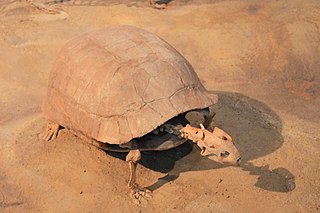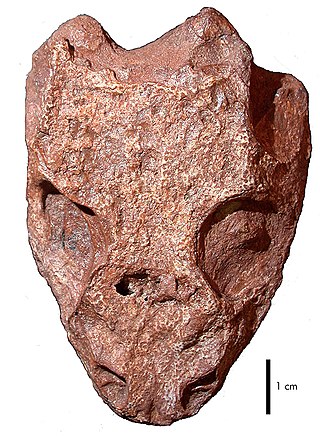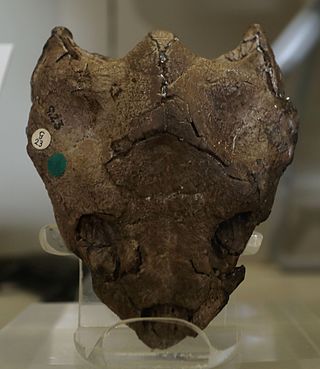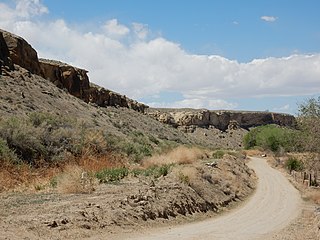| Guacamaya Formation | |
|---|---|
| Stratigraphic range: Permian | |
| Type | Formation |
| Location | |
| Country | Mexico |
The Guacamaya Formation is a geologic formation in Mexico. It preserves fossils dating back to the Permian period.

Glyptodontopelta is a monospecific genus of nodosaurid dinosaur from New Mexico that lived during the Late Cretaceous in what is now the Naashoibito member of the Ojo Alamo Formation. The type and only species, Glyptodontopelta mimus, is known from numerous specimens that consist of osteoderms, a dentary, supraorbital and bone fragments. It was named in 2000 by Tracy Ford. Edmontonia australis is a junior synonym of Glyptodontopelta.
Dolabrosaurus is a genus of extinct reptile and a member of the family Drepanosauridae. Fossils of Dolabrosaurus have been found in the Chinle Formation of New Mexico.

Stylemys is the first fossil genus of dry land tortoise belonging to the order Testudines discovered in the United States. The genus lived in temperate to subtropical areas of North America, Europe, and Asia, based on fossil distribution. The genus was first described in 1851 by Joseph Leidy. The tortoise was common in the prehistoric Badlands, especially Nebraska and South Dakota. The species has also been found in the formations in and around Badlands National Park. Fossil fragments have also been found in the Palm Park Formation of New Mexico.

Parapontoporia is an extinct genus of dolphin that lived off the Pacific coast of North America from the Late Miocene until the genus' extinction during the Pliocene. It is related to the baiji. Fossils have been found in California and Mexico. The Tulare Formation is predominately freshwater, which suggests Parapontoporia may have been tolerant of both salt and fresh water.
The Evanston Formation is a geological formation in Wyoming whose strata date back to the Late Cretaceous. Dinosaur remains are among the fossils that have been recovered from the formation. The fossil formation also has the remains of prehistoric mammals from the Paleocene epoch.

Conjunctio is an extinct genus of dissorophid temnospondyl amphibian from the early Permian of New Mexico. The type species, Conjunctio multidens, was named by paleontologist Robert L. Carroll in 1964.
Denazinosuchus is a genus of goniopholidid mesoeucrocodylian. Its fossils have been recovered from the Upper Cretaceous Fruitland Formation and Kirtland Formation of the San Juan Basin, New Mexico. It is the most abundant and readily identifiable mesoeucrocodylian of the San Juan Basin, mostly due to its distinctive subrectangular, flattened, and sparsely pitted bony armor. It was first described in 1932 by Carl Wiman on the basis of a skull as a species of Goniopholis, G. kirtlandicus. Spencer G. Lucas and Robert M. Sullivan redescribed the species in 2003 and gave it its own genus, Denazinosuchus. To date, Denazinosuchus is only known from skull material, armor, and a thigh bone.
Dolichobrachium is a dubious genus of extinct poposaurid crurotarsan. Fossils have been found from the Popo Agie Formation in Wyoming and are of Late Triassic age. It was one of the first rauisuchians to have been named.

Dorsetochelys is an extinct genus of turtle from the Early Cretaceous of southern England and northwestern Germany.

Coahuilaceratops is a genus of ceratopsian dinosaur. It is a chasmosaurine ceratopsian which lived during the Late Cretaceous period in what is now southern Coahuila in northern Mexico. It is known from the holotype CPC 276, a partial skeleton of an adult individual which includes several skull elements. Another specimen, CPS 277, may represent a juvenile Coahuilaceratops. All specimens of Coahuilaceratops were collected from a single location in the middle strata of the Cerro del Pueblo Formation, which dates to between 72.5 and 71.4 million years ago.

Redondavenator is a genus of sphenosuchian, a type of basal crocodylomorph, the clade that comprises the crocodilians and their closest kin. It is known from a partial upper jaw and left shoulder girdle found in rocks of the Norian-Rhaetian-age Upper Triassic Redonda Formation, northeastern New Mexico. It is notable for its large size; the minimum estimated skull length for the holotype individual is 60 centimetres (2.0 ft). This makes it the largest Triassic crocodylomorph ever recorded.
Parrishia is an extinct genus of sphenosuchian crocodylomorph known from the Late Triassic Chinle, Dockum, and Santa Rosa Formations in Arizona and New Mexico.
Tecovasuchus is an extinct genus of aetosaur. It is known primarily from osteoderms found from the Tecovas Formation in Texas, which is Late Triassic in age, dating back to the lower Norian. Material is also known from several other localities of the Chinle Group in New Mexico and Arizona, such as older Carnian outcrops and younger Rhaetian outcrops. Specimens of Tecovasuchus have been collected from the Tecovas Formation, the Bluewater Creek Formation, and the Los Esteros Member of the Santa Rosa Formation.

The Pictured Cliffs Formation is a Campanian geologic formation in the San Juan Basin of New Mexico. Dinosaur remains are among the fossils that have been recovered from the formation, although none have yet been referred to a specific genus.

The Ojo Alamo Formation is a geologic formation in New Mexico spanning the Mesozoic/Cenozoic boundary. Non-avian dinosaur fossils have controversially been identified in beds of this formation dating from after the Cretaceous–Paleogene extinction event, but these have been explained as either misidentification of the beds in question or as reworked fossils, fossils eroded from older beds and redeposited in the younger beds.

Amtocephale is a genus of pachycephalosaurid dinosaur from early Late Cretaceous deposits of southern Gobi Desert, Mongolia.
The Morrow Formation is a geologic formation from the Pennsylvanian geological age that is found in locations ranging from Southeast New Mexico and West Texas to locations in Oklahoma, Southwestern Kansas, and Arkansas. It preserves fossils dating back to the Carboniferous period.
The Poison Canyon Formation is a geologic formation in the Raton Basin of Colorado and New Mexico. The formation was deposited from the late Cretaceous through the Paleocene.

The Olmos Formation is a geologic formation in Mexico. It preserves fossils of plants, hadrosaurs, ceratopsians, tyrannosaurs and the turtle Palauchelys montellanoi dating back to the Cretaceous period.

The New Mexico Library Association (NMLA) is a professional organization for New Mexico's librarians and library workers. It is headquartered in Albuquerque, New Mexico. It was officially founded on February 3, 1924. Evelyn Shuler, director of Raton Public Library and director for the ALA United War Work Campaign in New Mexico, was the organization's first president.
| | This section is empty. You can help by adding to it. (July 2017) |